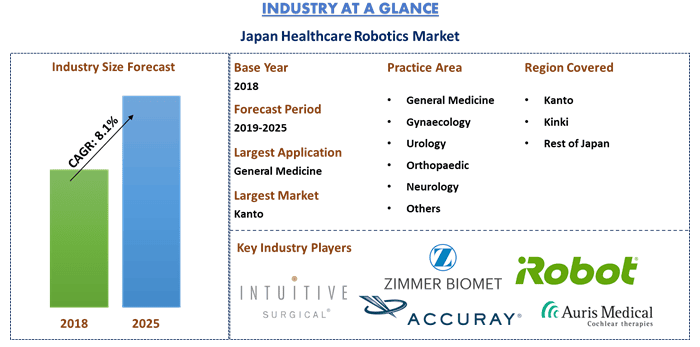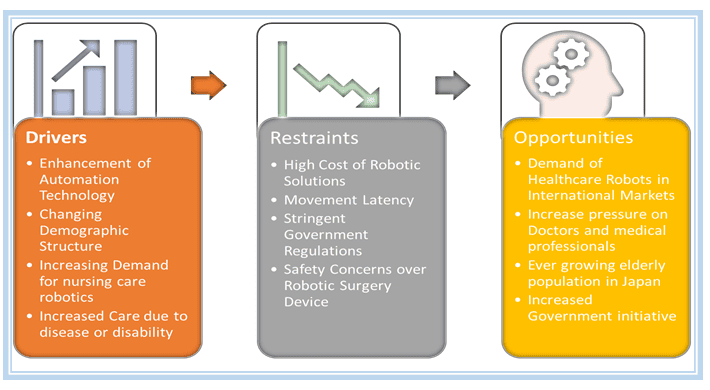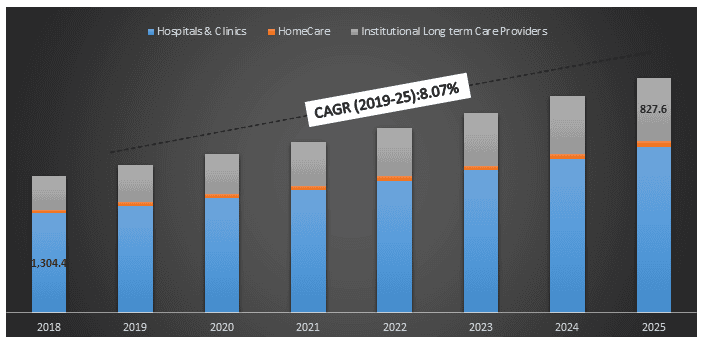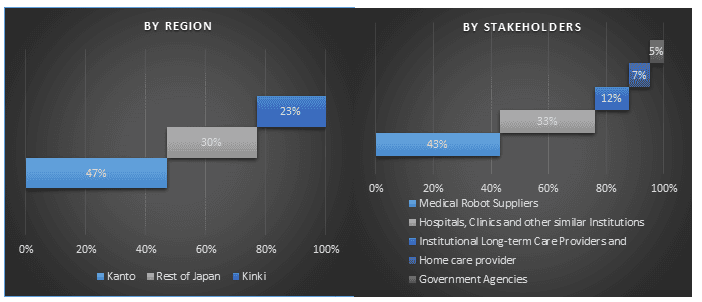일본 의료 로봇 시장은 2018년에 17억 9,610만 달러였으며, 2019-2025년 예측 기간 동안 연평균 성장률 8.1%로 성장할 것으로 예상됩니다. 일반적으로 사용되는 의료 로봇은 외과의사가 조종할 수 있는 로봇입니다. 시장에는 자율 수술 로봇도 있으며, 로봇은 인간의 통제 없이 작동할 수 있습니다. 자율 로봇은 특히 연조직을 봉합하거나 꿰매도록 설계되었습니다. 로봇 보조 시스템 캠페인 참가자들은 더 나은 수술 전 계획과 향상된 실행을 통해 더 나은 환자 결과를 자랑합니다. 로봇 수술의 인지된 장점은 적절하게 사용하면 통증이 적고, 조기 회복, 조기 복귀 및 환자 안전이 가능하다는 것입니다. 단점으로는 외과의사의 학습 곡선 동안 합병증 증가, 혈액 손실 증가, 보철물 정렬 불량, 비용 및 예측할 수 없는 결과가 있습니다.
일본 의료 로봇 시장 스냅샷
의료는 일본 시장에서 의사와 의료 종사자 수가 감소함에 따라 증가하는 고령화 인구를 해결하기 위해 기술이 기하급수적으로 성장하는 것을 목격했습니다. 전 세계의 주요 기업들은 이러한 영향을 추적하고 있으며 고령 인구의 모든 요구를 충족할 수 있는 혁신적인 로봇 기술을 개발하기 위해 기술에 투자하고 있습니다. 또한 효능, 적응성 및 비용 절감의 지속적인 개선은 로봇 보조 수술에 대한 관심을 증가시켰습니다.
"로봇 기술은 주로 일반 의료 서비스에 적용되며, 다른 기술은 건강 모니터링 및 관리 서비스입니다."
로봇 기술이 적용되는 응용/실습 분야를 기준으로 보고서는 시장을 의료 서비스, 건강 모니터링 및 관리 서비스로 분류합니다. 의료 로봇은 적어도 지난 20년 동안 치료에 점진적으로 혁명을 일으키고 있습니다. 이제 인간 희소성은 로봇이 전국 의료진의 정규 구성원이 되어 환자의 맥박을 측정하고, 생체 신호를 스캔하고, 사진을 찍고, 진료 기록을 읽을 수 있는 단계에 도달했습니다. 그런 다음 이 정보는 간호사 또는 의사 보조원에게 전송되어 의사에게 환자의 상태에 대해 조언할 수 있습니다.
"수술 로봇 시스템은 2018년 일본에서 주요 사용 제품 부문이었지만 2025년까지 재활 로봇 시스템이 수술 로봇 시스템을 추월할 것으로 예상됩니다."
제품 유형에 따라 시장은 수술 로봇 시스템, 재활 로봇 시스템, 진단 로봇, 병원 및 약국 로봇 시스템 및 기타 로봇 시스템으로 분류됩니다. 2018년에는 수술 로봇이 시장을 지배했지만 고령 인구 증가는 재활 로봇 시스템에 대한 수요를 더 많이 창출할 것입니다. 이러한 요인으로 인해 이 부문은 2025년까지 시장을 주도할 것으로 예상됩니다. 현재 개발 단계에서 로봇 수술은 몇 가지 확실한 이점을 제공하는 것으로 보입니다. 이러한 이점이 장기적으로 관련 비용보다 클지는 두고 볼 일입니다. 로봇 기술의 발전으로 미래의 수술 로봇은 더 작고 저렴하며 작동하기 쉬워 궁극적으로 수술에서 수용을 촉진하고 임상 사용을 개선하는 데 도움이 될 수 있습니다.
"응용 분야 중 일반 외과는 2018년에 주요 점유율을 차지했으며 2025년에도 선두를 유지할 것으로 예상됩니다."
응용 분야를 기준으로 일본 의료 로봇 시장은 일반 외과, 부인과 수술, 비뇨기과 수술, 정형외과 수술, 신경외과 수술 등으로 분류됩니다. 2018년에는 일반 외과가 응용 분야를 지배하여 6억 9,610만 달러의 수익을 창출했으며 그 뒤를 이어 정형외과 수술, 신경외과 수술, 부인과 수술 및 비뇨기과 수술이 있었습니다. 이 부문은 2025년까지 예측 기간 동안 연평균 성장률 XX%로 성장할 것으로 예상됩니다.
병원 및 클리닉은 2018년에 가장 큰 최종 사용자 부문이었으며 전반적으로 선두를 유지할 것으로 예상됩니다."
로봇 도우미는 인간 의료 전문가의 업무량을 줄이기 위해 일본 병원으로 진출하고 있습니다. 일본의 로봇 전략에 따르면 정부는 2020년까지 5명 중 4명의 간병 수혜자가 로봇이 제공하는 일부 지원을 수용하기를 원합니다. 또한 일본은 인구 고령화의 첨단에 있습니다. 따라서 노인 간호를 지원하기 위한 가정 모니터링 로봇과 같은 보조 기술이 개발되고 있습니다. 따라서 병원 및 클리닉, 가정 간호 및 기관 장기 간호 제공자와 같은 최종 사용자는 의료 로봇을 최대한 많이 채택하도록 동기 부여를 받고 있습니다.
최종 사용자별 일본 의료 로봇 시장 규모,2018-2025년 (미화 백만 달러)
"간토 지역은 일본 의료 부문에서 로봇 기술 사용을 지배하고 있으며 예측 기간 동안 지배력을 유지할 것으로 예상됩니다."
일본에서 의료 로봇 기술의 전반적인 채택에 대한 더 나은 이해를 위해 일본에서 인구가 가장 많은 지역에 대한 심층 분석이 수행되었습니다. 간토와 긴키는 일본에서 인구가 가장 많은 지역입니다. 간토 지역은 일본에서 의료 로봇 사용을 지배했습니다. 긴키 지역에서는 교토 대학교 병원에 다빈치 수술 로봇을 사용하는 수술 부서가 있으며 교토 부립 의과 대학교 병원과 함께 있습니다. 또한 교토 대학교 흉부 외과는 로봇 보조 수술을 시작하여 표준 접근 방식으로 만들었습니다. 일본의 나머지 지역에는 홋카이도, 도호쿠, 주부, 주고쿠, 시코쿠 및 규슈와 같은 일본의 나머지 6개 지역이 포함됩니다.
경쟁 환경 - 상위 10개 시장 플레이어
일본 의료 로봇 기술 시장에서 활동하는 주요 기업은 Intuitive surgical, Zimmer Biomet, Mazor Robotics, Accuray Incorporated, Hansen Medical Inc./Auris, Stryker corporation, Toyota Industries Corporation, Hitachi Healthcare Manufacturing, Ltd., Panasonic Corporation 및 Fujitsu, Ltd.입니다. 이들 회사는 성장하는 일본 의료 로봇 시장에서 생존하기 위해 혁신적인 제품 출시, R&D 투자, 파트너십, 합병 등 수많은 성장 전략을 채택했습니다.
구매 이유(연구 보고서 제시):
- 가치(미화$) 측면에서 2018년부터 2025년까지 현재 및 미래 시장 규모
- 업계의 핵심 오피니언 리더를 통한 심층적인 2차 연구 및 1차 연구의 입력 결합 분석
- 일본에서 다양한 종류의 질병 유병률에 대한 자세한 분석
- 일본의 의료 상태에 대한 심층 분석
- 일본의 의료 관광 산업 분석 및 해당 부문을 개선하기 위해 수행된 다양한 이니셔티브
- 일본 및 기타 주요 국가의 의료 치료 비용 비교
- 전반적인 산업 성과에 대한 빠른 검토
- 주요 산업 플레이어에 대한 심층 분석
- 산업에서 널리 퍼져 있는 규제 프레임워크, 동인, 제약, 주요 추세 및 기회에 대한 자세한 분석
- Porter의 Five Forces 분석을 통해 산업 매력도 검토
- 이 연구는 유럽 기술의 다양한 부문 및 하위 부문에 걸쳐 시장을 포괄적으로 다룹니다.
- 다루는 지역: 간토, 긴키 및 일본의 나머지 지역
맞춤 설정 옵션:
일본 의료 로봇 시장은 일본 내 다른 지역 또는 다른 국가에 맞게 맞춤 설정할 수 있습니다. 이 외에도 UMI는 고객이 고유한 비즈니스 요구 사항을 가질 수 있음을 이해하므로 고객에게 완전 맞춤형 솔루션도 제공합니다.
목차
일본 의료용 로봇 기술의 역사적 시장 분석, 현재 시장 추정, 미래 시장 예측은 일본의 여러 지역에서 의료용 로봇의 전체 시장을 만들고 분석하기 위해 수행된 세 가지 주요 단계였습니다. 기술의 역사적 시장과 현재 시장의 전반적인 추정을 수집하기 위해 철저한 2차 연구가 수행되었습니다. 둘째, 이러한 통찰력을 검증하기 위해 수많은 결과와 가정이 고려되었습니다. 또한, 일본 의료용 로봇 시장의 가치 사슬 전반에 걸쳐 업계 전문가들과 심층적인 1차 인터뷰가 진행되었습니다. 모든 가정, 시장 규모 측정, 1차 인터뷰를 통한 시장 수치 검증 후, 기술의 전체 시장 규모를 예측하기 위해 하향식 접근 방식이 사용되었습니다. 그 후, 시장 세분화 및 데이터 삼각 측량 방법이 채택되어 기술의 세그먼트 및 하위 세그먼트의 시장 규모를 추정하고 분석했습니다. 자세한 방법론은 아래에 설명되어 있습니다.
역사적 시장 규모 분석
1단계: 2차 출처에 대한 심층 연구:
연례 보고서 및 재무 제표, 실적 발표, 보도 자료 등과 같은 회사 내부 출처와 무역 저널, 뉴스 및 기사, 정부 간행물, 경제 데이터, 경쟁사 간행물, 부문 보고서, 규제 기관 간행물, 안전 표준 기관, 타사 데이터베이스 및 기타 신뢰할 수 있는 간행물을 포함한 외부 출처를 통해 일본 의료용 로봇 기술의 역사적 시장 규모를 얻기 위해 자세한 2차 연구가 수행되었습니다. 경제 데이터 수집을 위해 World Bank, IMF, Trading Economics 등과 같은 출처가 사용되었습니다. 또한 일본 노동 복지부에서 데이터를 수집했습니다.
2단계: 시장 세분화:
역사적 시장 규모를 확보한 후, 일본 의료용 로봇 기술에 대한 다양한 세그먼트 및 하위 세그먼트에 대한 역사적 시장 통찰력과 점유율을 수집하기 위해 자세한 2차 분석이 수행되었습니다. 보고서에 포함된 주요 세그먼트는 진료 영역, 제품, 응용 분야 및 최종 사용자에 따른 의료용 로봇입니다. 또한 일본 의료용 로봇 시장의 주요 세그먼트의 하위 세그먼트에 대한 분석도 수행되었습니다.
3단계: 요인 분석:
다양한 세그먼트 및 하위 세그먼트의 역사적 시장 규모를 확보한 후, 일본의 의료용 로봇의 현재 시장 규모를 추정하기 위해 자세한 요인 분석이 수행되었습니다. 질병 유병률, 고령 인구 증가, 의료 서비스를 위한 로봇 기술의 고객 채택률과 같은 종속 및 독립 변수를 사용하여 요인 분석을 수행했습니다. 또한 병원, 클리닉 및 가정에서 기술의 전반적인 채택에 대한 분석도 수행되었습니다. 최근 과거에 일본 의료용 로봇 시장의 역사적 추세와 시장 규모 및 점유율에 대한 연간 영향이 분석되었습니다. 수요 및 공급 측면 시나리오도 철저히 연구되었습니다.
현재 시장 규모 추정 및 예측
현재 시장 규모 측정: 위 3단계의 실행 가능한 통찰력을 바탕으로 현재 시장 규모, 주요 응용 분야 및 시장의 주요 업체, 이러한 업체의 시장 점유율, 업계의 공급망 및 업계의 가치 사슬에 도달했습니다. 필요한 모든 백분율 점유율, 분할 및 시장 세분화는 위에서 언급한 2차 접근 방식을 사용하여 결정되었으며 1차 인터뷰를 통해 검증되었습니다.
추정 및 예측: 시장 추정 및 예측을 위해 시장 동인 및 추세, 제약 및 시장에서 사용할 수 있는 기회를 포함한 다양한 요인에 가중치가 할당되었습니다. 이러한 요인을 분석한 후 관련 예측 기법(즉, 하향식/상향식)을 적용하여 일본 의료용 로봇 시장의 주요 세그먼트 및 하위 세그먼트에 대해 2025년에 대한 시장 예측에 도달했습니다. 시장 규모를 추정하기 위해 채택된 연구 방법론은 다음과 같습니다.
- 가치(US$) 및 일본의 의료용 로봇 채택률 측면에서 업계의 시장 규모
- 주요 시장 세그먼트 및 하위 세그먼트의 모든 백분율 점유율, 분할 및 세분화
- 주요 응용 분야 및 시장의 주요 업체와 각 업체의 시장 점유율. 또한 일본에서 끊임없이 성장하는 의료용 로봇 시장에서 경쟁하기 위해 이러한 업체가 채택한 성장 전략
시장 규모 및 점유율 검증
1차 연구: 최고 경영진(CXO/VP, 영업 책임자, 마케팅 책임자, 운영 책임자 및 지역 책임자 등)을 포함한 주요 오피니언 리더(KOL)와 심층 인터뷰가 진행되었습니다. 1차 연구 결과가 요약되었고 명시된 가설을 증명하기 위해 통계 분석이 수행되었습니다. 1차 연구의 입력은 2차 결과와 통합되어 정보를 실행 가능한 통찰력으로 전환했습니다.
1차 참가자 분할
시장 엔지니어링
전반적인 시장 엔지니어링 프로세스를 완료하고 일본의 의료용 로봇 시장에 대한 각 세그먼트 및 하위 세그먼트의 정확한 통계 수치에 도달하기 위해 데이터 삼각 측량 기술이 사용되었습니다. 데이터는 수술용 로봇, 재활 로봇, 진단 로봇, 병원 및 약국 로봇 및 기타 로봇 시스템을 포함하여 일본의 의료 분야를 위한 주요 로봇 솔루션의 다양한 매개변수 및 추세를 연구한 후 여러 세그먼트 및 하위 세그먼트로 분할되었습니다. 또한 병원 및 클리닉, 장기 요양 기관 및 가정 요양 제공자를 포함하여 의료용 로봇의 최종 사용자를 고려했습니다. 이 외에도 간토, 긴키 및 일본의 나머지 지역을 포함하여 일본에서 인구가 가장 많은 지역에서 로봇 기술의 전반적인 채택에 대한 지식을 얻기 위해 분석이 수행되었습니다.
일본 의료용 로봇 시장 연구의 주요 목표
일본 의료용 로봇 시장의 현재 및 미래 시장 동향이 연구에 명확하게 나와 있습니다. 투자자는 연구에서 수행된 질적 및 양적 분석에서 투자를 위한 재량권을 확보하기 위한 전략적 통찰력을 얻을 수 있습니다. 현재 및 미래 시장 동향은 시장의 전반적인 매력도를 결정하여 산업 참가자가 미개척 시장을 활용하여 선점자 이점을 누릴 수 있는 플랫폼을 제공합니다. 연구의 다른 양적 목표는 다음과 같습니다.
- 가치(US$) 측면에서 일본 의료용 로봇의 현재 및 예측 시장 규모 분석
- 시장의 주요 세그먼트 및 하위 세그먼트의 현재 및 예측 시장 규모 분석. 연구의 세그먼트에는 진료 영역, 제품 유형, 응용 분야 및 최종 사용자에 따른 로봇 솔루션이 포함됩니다.
- 일본 의료용 로봇 시장에서 사용되는 기술 및 프로토콜 정의 및 설명
- 고객 및 경쟁사 분석 등과 함께 기술과 관련된 잠재적 위험 예측
- 일본 의료용 로봇 시장에 대한 정부 규정 정의 및 분석
- 일본 의료용 로봇 시장의 경쟁 환경과 끊임없이 성장하는 시장에서 생존하기 위해 시장 참여자가 채택한 성장 전략을 정의하고 분석합니다.
- 다른 주요 시장에 비해 일본에서 이루어지는 치료의 비용 효율성 분석
- 일본의 전반적인 의료 관광 산업과 해당 부문을 향상시키기 위해 수행된 이니셔티브 분석
- 일본의 다양한 종류의 질병 유병률 분석, 결과적으로 일본 인구의 전반적인 건강 상태 분석
관련 보고서
이 상품을 구매한 고객님들도 함께 구매하신 상품














